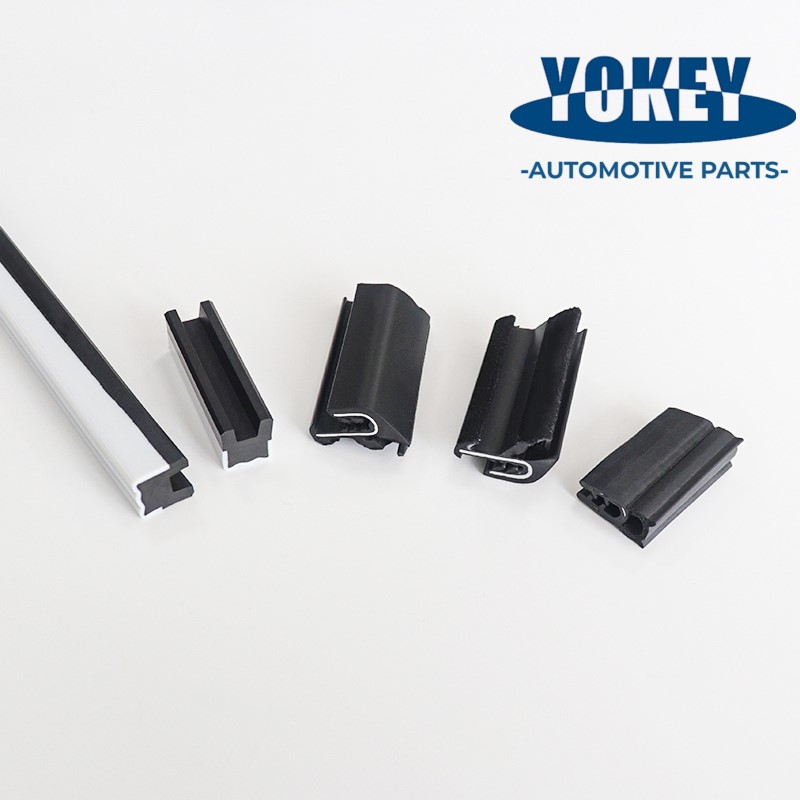Common rubber materials——EPDM’s characteristic
Advantage:
Very good aging resistance, weather resistance, electrical insulation, chemical corrosion resistance and impact elasticity.
Disadvantages:
Slow curing speed; It is difficult to blend with other unsaturated rubbers, and the self adhesion and mutual adhesion are very poor, so the processing performance is poor.
Ningbo Yokey Automotive Parts Co., Ltd focuses on solving customers’ rubber material problems and designing different material formulations based on different application scenarios.
Properties: details
1. Low density and high filling
Ethylene propylene rubber is a kind of rubber with a lower density of 0.87. In addition, a large amount of oil can be filled and fillers can be added, which can reduce the cost of rubber products and make up for the high price of raw rubber of ethylene propylene rubber. In addition, for ethylene propylene rubber with high Mooney value, the physical and mechanical energy after high filling will not be reduced by much.
2. Aging resistance
Ethylene propylene rubber has excellent weather resistance, ozone resistance, heat resistance, acid and alkali resistance, water vapor resistance, color stability, electrical performance, oil filling and room temperature fluidity. Ethylene propylene rubber products can be used for a long time at 120 ℃, and can be used briefly or intermittently at 150 – 200 ℃. The use temperature can be increased by adding appropriate antioxidant. EPDM crosslinked with peroxide can be used under harsh conditions. When the ozone concentration of EPDM is 50 pphm and the stretching time is 30%, the EPDM can reach 150 h without cracking.
3. Corrosion resistance
Due to the lack of polarity and low unsaturation of ethylene propylene rubber, it has good resistance to various polar chemicals such as alcohol, acid, alkali, oxidant, refrigerant, detergent, animal and vegetable oil, ketone and grease; However, it has poor stability in fatty and aromatic solvents (such as gasoline, benzene, etc.) and mineral oils. The performance will also decline under the long-term action of concentrated acid. In ISO/TO 7620, the data on the effects of nearly 400 corrosive gaseous and liquid chemicals on the properties of various rubbers are collected, and the 1-4 grades are specified to indicate their effects. The effects of corrosive chemicals on the properties of rubbers are as follows:
Effect of Grade Volume Swelling Rate/% Hardness Reduction on Properties
1<10<10 Slight or none
2 10-20<20 smaller
3 30-60<30 Medium
4>60>30 serious
4. Water vapor resistance
EPDM has excellent steam resistance and is estimated to be superior to its heat resistance. In the 230 ℃ superheated steam, the appearance does not change after nearly 100 hours. However, under the same conditions, the appearance of fluorine rubber, silicon rubber, fluorosilicone rubber, butyl rubber, nitrile rubber and natural rubber deteriorated significantly in a short time.
5. Resistance to superheated water
Ethylene propylene rubber also has good resistance to superheated water, but it is closely related to all vulcanization systems. The mechanical properties of ethylene propylene rubber (EPR) vulcanized with dimorphine disulfide and TMTD were little changed after being immersed in 125 ℃ superheated water for 15 months, and the volume expansion rate was only 0.3%.
6. Electrical performance
Ethylene propylene rubber has excellent electrical insulation and corona resistance, and its electrical properties are superior to or close to those of styrene butadiene rubber, chlorosulfonated polyethylene, polyethylene and cross-linked polyethylene.
7. Elasticity
Because ethylene propylene rubber has no polar substituents in its molecular structure and low molecular cohesion energy, its molecular chain can maintain flexibility in a wide range, second only to natural rubber and cis polybutadiene rubber, and can still maintain at low temperatures.
8. Adhesion
Due to the lack of active groups in the molecular structure of ethylene propylene rubber, the cohesion energy is low, and the rubber is easy to spray, so the self adhesion and mutual adhesion are very poor.
Post time: Oct-10-2022

